|
|
Table of Contents
Trend Lines
What Are Trend Lines, How Are They Used, and Why Are They Important?
Trend lines are straight lines that connect two or more price points on a chart to identify and confirm trends.
In technical analysis, trend lines are a fundamental tool that traders and analysts use to identify and anticipate the general pattern of price movement in a market. Essentially, they represent a visual depiction of support and resistance levels in any time frame.
The importance of trend lines in technical analysis lies in their ability to provide a clear visual representation of market trends and potential reversal points, which can help traders make informed trading decisions. They provide a simple yet effective means to identify and anticipate market behavior.
Many of the principles applicable to support and resistance levels can be applied to trend lines as well. It's important that you understand all of the concepts presented in our Support and Resistance article before continuing on.
What Is an Uptrend Line?
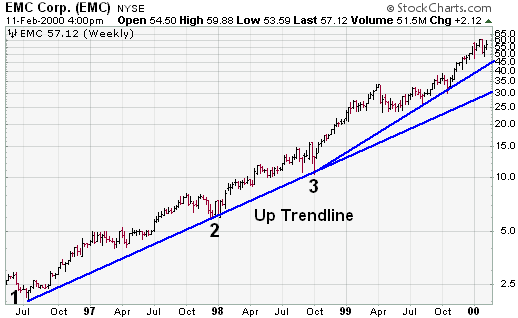
An uptrend line has a positive slope and is formed by connecting two or more low points. The second low must be higher than the first for the line to have a positive slope. Note that at least three points must be connected before the line is considered a valid trend line.
Uptrend lines act as support and indicate that net demand (demand less supply) is increasing even as the price rises. A rising price combined with increasing demand is very bullish and shows a strong determination on the part of the buyers. As long as prices remain above the trend line, the uptrend is considered solid and intact. A break below the uptrend line indicates that net demand has weakened, and a change in trend could be imminent.
What Is a Downtrend Line?
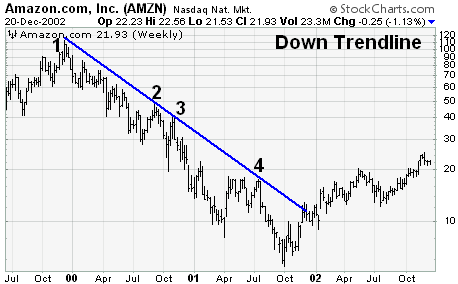
A downtrend line has a negative slope formed by connecting two or more high points. The second high must be lower than the first for the line to have a negative slope. Note that at least three points must be connected before the line is considered a valid trend line.
Downtrend lines act as resistance and indicate that net supply (supply less demand) is increasing even as the price declines. A declining price combined with increasing supply is very bearish and shows the strong resolve of the sellers. As long as prices remain below the downtrend line, the downtrend is solid and intact. A break above the downtrend line indicates that the net-supply is decreasing and that a trend change could be imminent.
For a detailed explanation of trend changes, which are different from trend line breaks, please see our article on the Dow Theory.
Scale Settings for Trend Lines
High and low points appear to line up better for trend lines when prices are displayed using a semi-log scale. This is especially true when long-term trend lines are being drawn or when there is a large change in price. Most charting programs allow users to set the scale as arithmetic or semi-log. An arithmetic scale displays incremental values (5,10,15,20,25,30) evenly as they move up the y-axis. A $10 movement in price will look the same from $10 to $20 or $100 to $110. A semi-log scale displays incremental values in percentage terms as they move up the y-axis. A move from $10 to $20 is a 100% gain and would appear to be much larger than a move from $100 to $110, which is only a 10% gain.
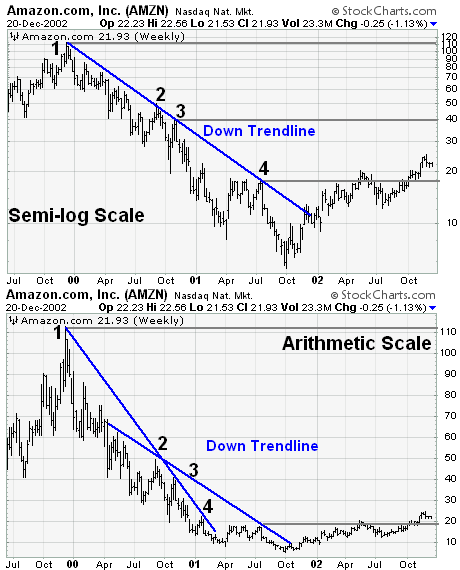
In the case of Amazon.com (AMZN), there were two false breaks above the downtrend line as the stock declined between 2000 and 2001. These false breakouts could have led to premature buying as the stock continued to decline after each one. The stock lost 60% of its value three times over two years. The semi-log scale reflects the percentage loss evenly, and the downtrend line was never broken.
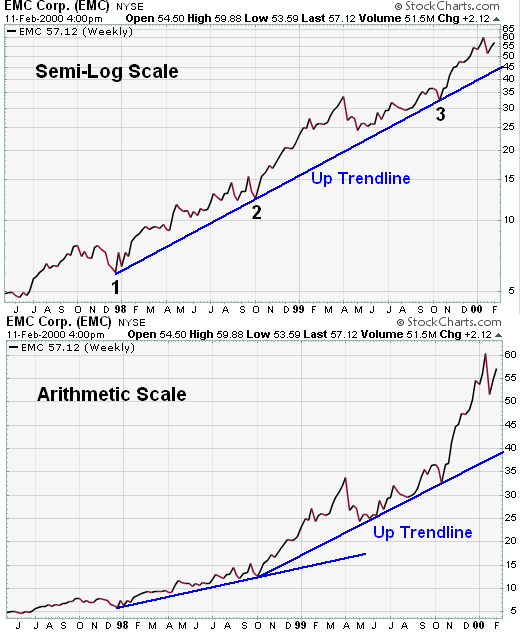
In the case of EMC, there was a large price change over a long period. While there were not any false breaks below the uptrend line on the arithmetic scale, the rate of ascent appears smoother on the semi-log scale. EMC doubled three times in less than two years. On the semi-log scale, the trend line fits all the way up. On the arithmetic scale, three different trend lines were required to keep pace with the advance.
How Do You Validate a Trend Line?
It takes two or more points to draw a trend line. The more points used to draw the trend line, the more validity attached to the support or resistance level represented by the trend line. It can sometimes be difficult to find more than 2 points from which to construct a trend line. Even though trend lines are an important aspect of technical analysis, it's not always possible to draw trend lines on every price chart. Sometimes the lows or highs just don't match up, and it is best not to force the issue. The general rule in technical analysis is that it takes two points to draw a trend line and the third point confirms the validity.
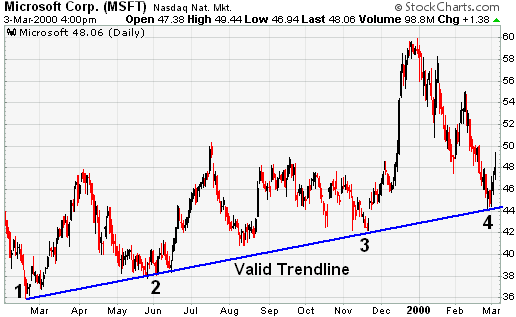
The chart of Microsoft (MSFT) shows an uptrend line that has been touched four times. After the third touch in Nov-99, the trend line was considered a valid line of support. Now that the stock has bounced off of this level a fourth time, the soundness of the support level is enhanced even more. As long as the stock remains above the trend line (support), the trend will remain in control of the bulls. A break below would signal that net supply was increasing and that a change in trend could be imminent.
What Are the Spacing Rules for Trend Lines?
The lows used to form an uptrend line, and the highs used to form a downtrend line should not be too far apart or too close together. The most suitable distance apart will depend on the timeframe, the degree of price movement, and personal preferences. If the lows (highs) are too close together, the validity of the reaction low (high) may be in question. If the lows are too far apart, the relationship between the two points could be suspect. An ideal trend line comprises relatively evenly spaced lows (or highs). The trend line in the above MSFT example represents well-spaced low points.
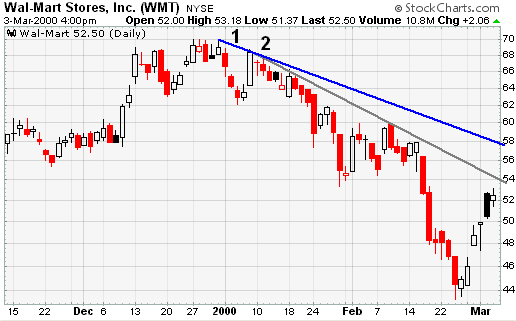
On the WalMart (WMT) example, the second high point appears too close to the first high point for a valid trend line; however, it would be feasible to draw a trend line beginning at point 2 and extending down to the February reaction high.
What Are Trend Angles?
As the steepness of a trend line increases, the validity of the support or resistance level decreases. A steep trend line results from a sharp advance (or decline) over a brief period. The angle of a trend line created from such sharp moves is unlikely to offer a meaningful support or resistance level. Even if the trend line is formed with three seemingly valid points, attempting to play a trend line break or to use the support and resistance level established, it will often prove difficult.
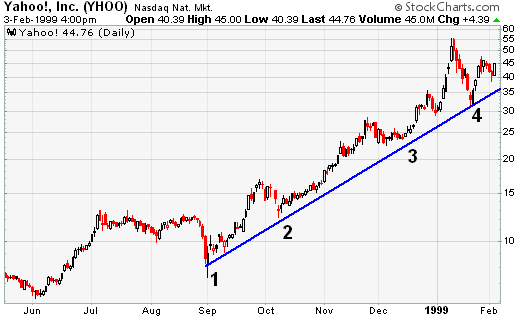
The trend line for Yahoo! (YHOO) was touched four times over 5 months. The spacing between the points appears OK, but the steepness of the trend line could be more sustainable, and the price is more likely than not to drop below the trend line. However, trying to time this drop or make a play after the trend line is broken is a difficult task. The amount of data displayed and the chart size can affect the angle of a trend line. When assessing the validity and sustainability of a trend line, keep in mind that short and wide charts are less likely to have steep trend lines than long and narrow charts.
What Are Internal Trend Lines?
Sometimes there appears to be the possibility of drawing a trend line, but the exact points do not match up cleanly. The highs or lows might be out of whack, the angle might be too steep, or the points might be too close together. If one or two points could be ignored, a fitted trend line could be formed. With the volatility present in the market, prices can overreact, producing spikes that distort the highs and lows. One method for dealing with over-reactions is to draw internal trend lines, which ignore these price spikes to a reasonable degree.
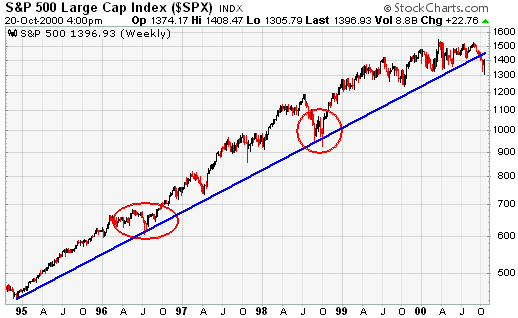
The long-term trend line for the S&P 500 ($SPX) extends up from the end of 1994 and passes through low points in Jul-96, Sept-98, and Oct-98. These lows were formed with selling climaxes and represented extreme price movements that protruded beneath the trend line. By drawing the trend line through the lows, the line appears at a reasonable angle, and the other lows match up extremely well.
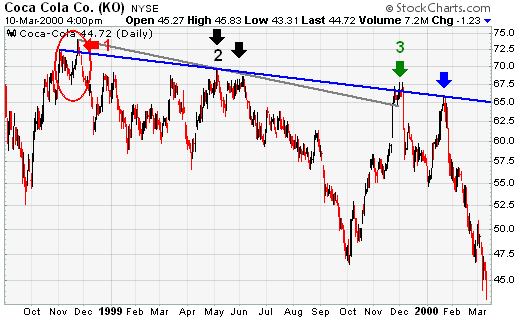
Sometimes, a price cluster with a high or low spike sticks out. A price cluster is an area where prices are grouped within a tight range over some time. The price cluster can be used to draw the trend line, and the spike can be ignored. The chart of Coca-Cola (KO) shows an internal trend line that is formed by ignoring price spikes and using price clusters instead. In October and November 1998, KO formed a peak, with the November peak just higher than the October peak (red arrow). If the November peak had been used to draw a trend line, the slope would have been more negative, and there would have appeared to be a breakout in Dec-98 (gray line). However, this would have only been a two-point trend line because the May-June highs are too close together (black arrows). Once the Dec-99 peak formed (green arrow), it would have been possible to draw an internal trend line based on the price clusters around the Oct/Nov-98 and the Dec-99 peaks (blue line). This trend line is based on three solid touches, and it accurately forecasts resistance in Jan-00 (blue arrow).
The Bottom Line
Trend lines can offer great insight, but, if used improperly, can also produce false signals. Other items - such as horizontal support and resistance levels or peak-and-trough analysis - should be employed to validate trend line breaks.
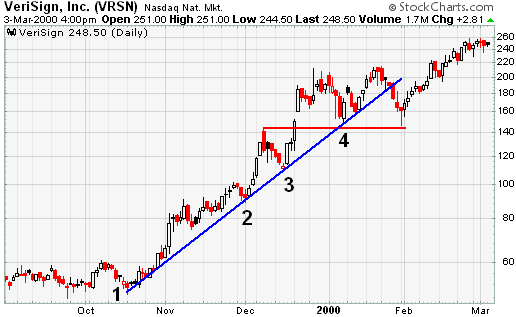
While trend lines have become a very popular aspect of technical analysis, they are merely one tool for establishing, analyzing, and confirming a trend. The uptrend line for VeriSign (VRSN) was touched 4 times and seemed to be a valid support level. Even though the trend line was broken in Jan-00, the previous reaction low held and did not confirm the trend line break. In addition, the stock recorded a new higher high prior to the trend line break.
Trend line breaks should not be the final arbiter, but should serve merely as a warning that a change in trend may be imminent. By using trend line breaks for warnings, investors and traders can pay closer attention to other confirming signals for a potential change in trend.
Trend Line FAQs
Why are trend lines significant in technical analysis?
Trend lines visually illustrate the direction of price trends and can also help identify potential support and resistance levels. They can also produce false signals if used improperly, so they should be used in combination with other technical analysis tools to validate trend line breaks.
What should traders do when a trend line breaks?
A break in a trend line serves as a warning that a change in trend may be imminent. However, this should not be the final deciding factor. Traders should also look at other confirming signals, like horizontal support and resistance levels or peak-and-trough analysis, for a potential change in trend.
What is the significance of the spacing of points in a trend line?
The lows used to form an uptrend line and the highs used to form a downtrend line shouldn't be too far apart or too close together. If they're too close, the validity of the reaction low or high may be questionable. If they are too far apart, their relationship could be suspect. Ideally, an uptrend or downtrend line is formed with relatively evenly-spaced lows or highs.
How does the angle of a trend line affect its validity?
The steeper the trend line, the lesser its validity as a support or resistance level. Steep trend lines often result from sharp advances or declines over a brief period. These lines may not offer meaningful support or resistance levels even if they are formed with three seemingly valid points.
What are internal trend lines, and how are they useful?
Internal trend lines can be drawn when the exact points for a conventional trend line don't match up cleanly. They ignore price spikes and overreactions to a reasonable degree, focusing more on the overall trend in market prices.
